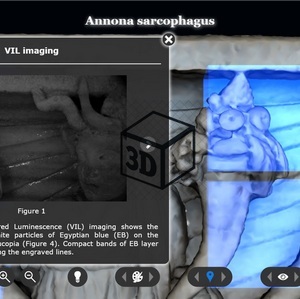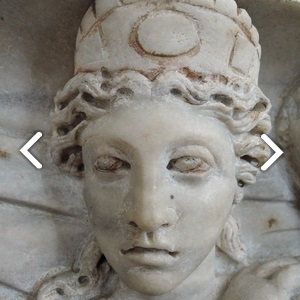Aim of the project
The aim of this project is to extends and improves the systematic and multidisciplinary method proposed and tested on the Ulpia Domnina's sarcophagus (MNT-TD, inv. no 125891) to detect, document and visualize the preserved (and in some cases the digital reconstructed) original colour and gilding on Roman marble sarcophagi (I-IV century AD).
Case-study
The test activity has been carried out on the so-called Annona sarcophagus at the Museo Nazionale Romano - Palazzo Massimo (inv. no. 40799). This rectangular sarcophagus without lid is decorated only in the frontal part with allegorical characters: Portus, Annona, Concordia (behind a married couple making a dextrarum iunctio), Genius Senati, Abundantia, and Africa (from the right to the left of the sarcophagus). It was made of Preconnesian marble in Rome and is dated at the last third of 3rd century (270-280 AD).
The sarcophagus was select because it presents several visible colour and gilding traces and it poses interesting open problems on their application techniques. The academic literature reports that the sarcophagus shows a great amount of red and gilding (Aquari 1877; Musso-Friggeri 1985).
The main goals for this case study are:
- to verify the presence of other colours besides the red;
- to characterize the used pigments and dyes;
- to identify the application techniques of the colour and gilding;
- to provide documentary evidence to understand and virtually reconstruct the original polychromy;
- the 3D integration and interactive visualization of all (raw and processed) data.
Methodology and testing activity
Using an interdisciplinary approach, the preliminary step has involved the archaeological and historical research, and the direct visual inspection with naked eye and through a portable stereoscope that allowed solving doubts about the authenticity of some pictorial elements.
The following step has been the identification of the areas where to perform non-invasive analyses based on multispectral imaging and spectroscopic technique. In particular, the VIL imaging has played a key role to characterize the spatial distribution of Egyptian blue pigment, while the UVL imaging for the localization of organic binders and dyes as, for example, the rose madder lake.
Subsequently, some micro-samples are taken to do more accurate laboratory analyses because the surface presents overlapped layers with interesting features and difficult interpretation.
The on-site step acquisition data has completed by an accurate polychrome surface acquisition by colour calibrated 2D images and a 3D digitalization of the artefact using passive 3D scanning technologies.
The research has involved the processing of the acquired data in laboratory. On one side, there is the 2D/3D data processing to create a high-resolution 3D model (72 millions of triangles); on the other side, the selected micro-samples examination by Optical Petrographic Microscopy (OPM) and Raman spectroscopy to extract further information.
Data integration and visualization
On end the different diagnostics modalities and the archaeological data are integrated with a high-resolution 3D model. In order to allow that we have developed specific components for 3D Heritage Online Presenter (3DHOP), where the 3D models is used to manage and display all achieved information about the ancient polychromy (colour and gilding) and the history of the sarcophagus.
The advantages of the 3DHOP framework for our method are: an easy and interactive visualization of 3D models directly inside HTML pages, with all the types of achieved data; the streaming of multiresolution 3D meshes over HTTP, supporting the exploration of very large models on commodity computers and standard internet connections.
The main features of the designed system, useful both for the analytical process and the dissemination, are:
- the interactive navigation of the 3D multi-resolution model with the possibility to freely examine any details of the artefact using the zoom and pan commands;
- the interactive navigation using a predefined set of views related to most interesting details;
- the possibility to interact with a directional light that can help to highlight some details of the relief otherwise not discernible;
- the management of the information in multiple levels with more attention to the scientific analyses data;
- the placing of a set of hotspots to link the different data to the 3D model. The hotspots are subdivided in different groups that can be visually identified by using different colours. In our case each group correspond to a different acquired data (e.g. VIL and UVL imaging, OPM, Raman spectroscopy, etc.). For each hotspot there is the possibility to associate a movable window that allows the user to consult the hotspot data content;
- the interactive visualization of the geometrical 3D model and the scientific polychrome reconstructions in multiple levels. Specifically we can switch from the current colour to the original virtual colour proposal (or more presumed reconstructions) by clicking the palette colours icon.
Clicking on the image below you can visualize the skills of 3DHOP specifically created for the polychromy. Selecting the next image it is possible to watch a demonstration video.


At present the virtual polychrome reconstruction of the Africa personification is only a test to show the potentiality of the system.
Results
The integration (and visualization) of the archaeological data and the scientific analyses results through a high-resolution 3D model represents a novelty in the study of the ancient polychromy and allows significant improvement for its knowledge.
We have detected new pigments (Egyptian blue and white lime) and probably a rose madder lake vegetable dye; we have also identified so the techniques used to apply the colour and gilding on the marble surface.
We have developed new components created to visualize and disseminate all collected (raw and processed) datasets via the Web thanks to high-resolution 3D model, using the framework 3DHOP.
At the end of this analytical and multidisciplinary process, we have also obtained adequate scientific information to understand the history of the polychromy (colour and gilding) of the Annona sarcophagus and to propose as soon as possible a preliminary version of a 3D scientific polychrome reconstruction that is partially reliable. The current virtual reconstruction wants only to show the potentiality of the proposed digital system and multidisciplinary approach both for studying and dissemination.
Publications
E. Siotto, G. Palma, M. Potenziani, R. Scopigno 2015. Digital study and Web-based documentation of the colour and gilding on ancient marble artworks, in Digital Heritage International Congress 2015, Granada September 28 - October 2, IEEE, Vol. 1, 239-246.
News

Credits
Manager:
Eliana Siotto (VCG Lab ISTI-CNR, Pisa, IT)
Roberto Scopigno (VCG Lab ISTI-CNR, Pisa, IT)
Rita Paris (Soprintendenza Speciale per i Beni Archeologici di Roma - Director of the Museo Nazionale Romano - Palazzo Massimo, Rome, IT)
3D digitalization:
Eliana Siotto (VCG Lab ISTI-CNR, Pisa, IT)
3D data processing:
Gianpaolo Palma and Eliana Siotto (VCG Lab ISTI-CNR, Pisa, IT)
3D polychrome reconstruction:
Eliana Siotto (VCG Lab ISTI-CNR, Pisa, IT)
Photography:
Eliana Siotto (VCG Lab ISTI-CNR, Pisa, IT)
Archaeological and archival researches:
Eliana Siotto (VCG Lab ISTI-CNR, Pisa, IT)
Optical petrographic microscopy analysis:
Corrado Gratziu and Alessandra Moscato (University of Pisa, IT)
Raman spectroscopy analysis:
Stefano Legnaioli and Giulia Lorenzetti (ICCOM-CNR, Pisa, IT)
Lucia Burgio (Victoria & Albert Museum, London, UK)
Colorimetric analysis and multispectral visible and infrared imaging:
Vincenzo Palleschi (ICCOM-CNR, Pisa,IT)
VIL and UVL imaging:
Eliana Siotto, Gianpaolo Palma and Paolo Pingi (VCG Lab ISTI-CNR, Pisa, IT)
Samples activity:
Debora Papetti (Restorer at the Museo Nazionale Romano - Palazzo Massimo, Rome, IT)
3DHOP viewer:
Marco Potenziani and Eliana Siotto (VCG Lab ISTI-CNR, Pisa, IT)
Video:
Gianpaolo Palma and Eliana Siotto (VCG Lab ISTI-CNR, Pisa, IT)
Web design:
Federico Ponchio and Eliana Siotto (VCG Lab ISTI-CNR, Pisa, IT)
Acknowledgements:
Miria Roghi (Soprintendenza Speciale per i Beni Archeologici di Roma - Museo Nazionale Romano - Palazzo Massimo, Rome, IT)

